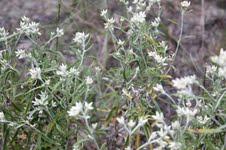Sweet Everlasting
“What is that sweet smell?” I wondered, as I walked the trail on our property with our lumbering Lab, Max. Just a subtle, gentle odor of something recognizable; perhaps the dog brushed against something as we walked. Ah, then I noticed it—Gnaphalium obtusifolium, recently renamed Pseudognaphalium obtusifolium, and commonly called sweet everlasting. This is one of my favorite end-of-summer native species of the Asteraceae family. And it’s more than a fragrant delight. Sweet everlasting has a solid history as medicinal ally. Linnaeus named this genus in 1753, according to Daniel Austin in Florida Ethnobotany. Native people mixed the plant with smoking tobacco, and even Julia Morton in Folk Remedies of the Low Country (1974) noted its use in pipes by “old timers” in the southeast.
Sweet everlasting is notable near summer’s end and reaches 24 to 36 inches. The leaves are alternate, narrow and lancelet, lacking stalks. They are green above, white and hairy below. The difference between the top and bottom is striking.
Although sweet everlasting is aromatic and inviting, it makes a rather bitter tea and it is quite astringent. Morton wrote that sweet everlasting was the most common native cold remedy in South Carolina, where it was widely taken as tea sweetened with sugar or honey. In the American EclecticDispensatory (1855), King noted that the leaves and flowers, when chewed and swallowed relieved sore throats and mouth ulcers. Morton also noted that the plant was often boiled with pine tops (Pinus palustris) and wax myrtle (Myrica cerifera) or salt bush (Baccharis halmifolia) or gallberry (Ilex glabra) or mullein (Verbascum Thapsus) and to used treat colds or flu.
Modern herbalist Matthew Wood tells us that sweet everlasting was and still is an important Cherokee medicine, and he shares intriguing bits of folklore in The Earthwise Herbal (2009) about how this plant received one of its many nicknames, “rabbit tobacco.” He writes at length about its use in respiratory ailments including asthma. Wood suggests harvesting the plant after it declines (based on, he writes, a spectro-chromatograph study by Alabama herbalist Dwight Collier), noting that the flower tops hold their scent. It would be interesting to dig deeper into the ethnobotanical lore to see if indeed the native people of the southeast used the plant after it had died, or if it was perhaps picked and dried.
Historically, sweet everlasting has also been used a “strewing” herb, which means it was thrown onto floors or placed around indoors areas to keep a fresh scent in the air before the advent of hardwood floors and disinfectants, and stuffed into pillows as well. It’s easy to see why as the aroma is intoxicating. Gather some soon before it disappears into the autumn shadows.
Ellie Sommer
Paynes Prairie Chapter/Gainesville FL
www.myherbalnotebook.com
Sweet everlasting is notable near summer’s end and reaches 24 to 36 inches. The leaves are alternate, narrow and lancelet, lacking stalks. They are green above, white and hairy below. The difference between the top and bottom is striking.
Although sweet everlasting is aromatic and inviting, it makes a rather bitter tea and it is quite astringent. Morton wrote that sweet everlasting was the most common native cold remedy in South Carolina, where it was widely taken as tea sweetened with sugar or honey. In the American EclecticDispensatory (1855), King noted that the leaves and flowers, when chewed and swallowed relieved sore throats and mouth ulcers. Morton also noted that the plant was often boiled with pine tops (Pinus palustris) and wax myrtle (Myrica cerifera) or salt bush (Baccharis halmifolia) or gallberry (Ilex glabra) or mullein (Verbascum Thapsus) and to used treat colds or flu.
Modern herbalist Matthew Wood tells us that sweet everlasting was and still is an important Cherokee medicine, and he shares intriguing bits of folklore in The Earthwise Herbal (2009) about how this plant received one of its many nicknames, “rabbit tobacco.” He writes at length about its use in respiratory ailments including asthma. Wood suggests harvesting the plant after it declines (based on, he writes, a spectro-chromatograph study by Alabama herbalist Dwight Collier), noting that the flower tops hold their scent. It would be interesting to dig deeper into the ethnobotanical lore to see if indeed the native people of the southeast used the plant after it had died, or if it was perhaps picked and dried.
Historically, sweet everlasting has also been used a “strewing” herb, which means it was thrown onto floors or placed around indoors areas to keep a fresh scent in the air before the advent of hardwood floors and disinfectants, and stuffed into pillows as well. It’s easy to see why as the aroma is intoxicating. Gather some soon before it disappears into the autumn shadows.
Ellie Sommer
Paynes Prairie Chapter/Gainesville FL
www.myherbalnotebook.com




Comments
--Penny
www.regionalconservation.org
You can search there for plants by scientific or latin names, see what they do, how to care for, and places they live. Great site.
--Penny
http://www.florida.plantatlas.usf.edu/Plant.aspx?id=3956
--Penny
http://fnpsblog.blogspot.com/2010_08_01_archive.html
--Penny